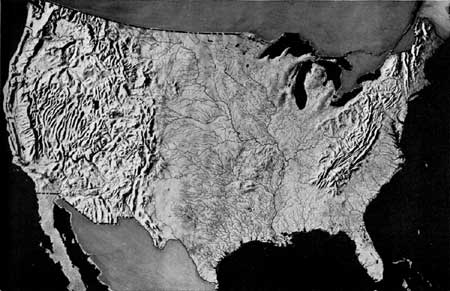![]()
MENU
SECTION I
SECTION II
History
Needs
![]() Geography
Geography
Historic Sites
Competitors
Economic Aspects
SECTION III
Federal Lands
State and Interstate
Local
SECTION IV
Division of Responsibility
Local
State
Federal
Circulation
SECTION V
Recreational Use of Land in the United States
SECTION II
RECREATIONAL RESOURCES AND HUMAN REQUIREMENTS
3. GEOGRAPHY OF RECREATION
Like all other natural resources, recreational resources exist where Nature has scattered them in careless abandon, and without any orderly relationship to human demand. When they are favorably situated with reference to populations, it can only be considered a matter of fortunate accident. Moreover, since the industry of man is definitely detrimental to those recreational resources whose principal value lies in their wilderness character, recreational areas of this particular type are nearly always remote from centers of human concentration.
Because the everyday outdoor recreational needs of the people must be met by facilities which are immediately at hand, large expenditures are constantly being made within city and metropolitan district boundaries for the purpose of restoring, at least to a semblance of natural character, areas whose natural recreation facilities have been spoiled by human activities.
It is well to note that even within a city the selection of recreational areas is governed to a large degree by topography. Natural ponds and lakes, the depressions occupied by streams, and the more rugged hilltops are areas whose natural characteristics give them preferred recreational value. Fortunately, such sites are frequently of minor value as real estate developments.
Geographical factors, more than anything else perhaps, are responsible for the element of Federal responsibility for recreation. Scenic, climatic, and wildlife resources do not recognize the boundaries of political subdivisions. Where use of these resources is had by all of the people, the Federal Government has the responsibility of safeguarding them. Recreational planning cannot be successful unless it takes into account the discrepancy between the distribution of populations and recreational resources.
Population—its nature and the pattern of its distribution—is of the greatest importance in locating areas which are to be devoted partly or wholly to recreation. A "counter pull" is exerted by a group of natural factors, some of which are almost generally given consideration, some of which are more often than not quite neglected. The very existence of these natural factors and their "pull" are inconsistent with the idea that there should, or ever could, be a more or less fixed pattern of distribution of the areas and facilities which people desire for their leisure time use. These factors, all of which need to be weighed against population distribution in the selection of parks and other recreational areas, appear to be as follows:
Land Reliefs
Variety of elevation is one of the important determinants in recreational value of land. Park folk in their search for recreational locations instinctively look for areas which possess this quality. Moreover, persons planning vacation trips are prone to seek locations whose altitudes are opposite from those of their home environments. Change of environment, as is well known, is in itself a recreational factor of the greatest importance. The altitude factor enters here with a special emphasis, because of the physical refreshment which most people experience from a change of environment of this particular sort.
The accompanying relief map of the United States (fig. 16) shows clearly the distribution of the principal mountain ranges of the country. It. emphasizes the fact that the majority are located in the western part of the country. Comparison of this map with the map (p. 26) of present and proposed Federal park areas demonstrates how variety of land relief has been a determinant in the selection of a majority of the national parks.

FIGURE 16.—Relief map of the United States.
(click on image for an enlargement in a new window)
Monotony is anathema to recreation. The maximum varieties of scenic interest are to be found in the rugged areas, whereas the plains only provide minor variations of the one scenic theme. All of a plain is usually within one life zone, whereas mountain ranges frequently include as many as five life zones. Thus, topographical variety brings a variety of flora and fauna. There are many other points which could be brought out to illustrate the importance of land relief in the recreational picture, but this hardly is necessary, since the recreational values of the mountains are universally recognized. Rugged areas are high in recreational value, but as a general thing they are remote from large population centers.
Continued >>>
Last Modified: Fri, Sep. 5, 2003 10:32:22 am PDT
http://www.cr.nps.gov/history/online_books/recreational_use/chap2-3.htm
![]()

 Top
Top